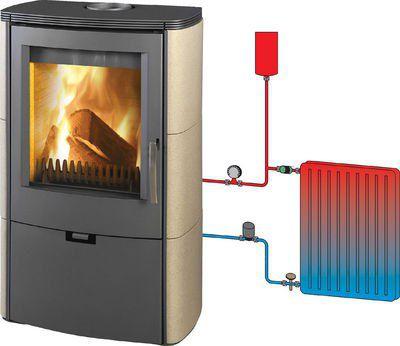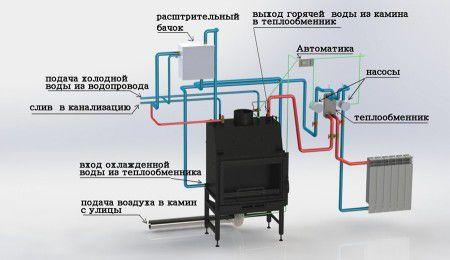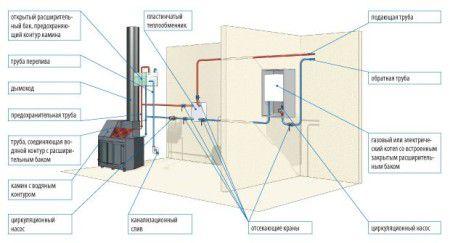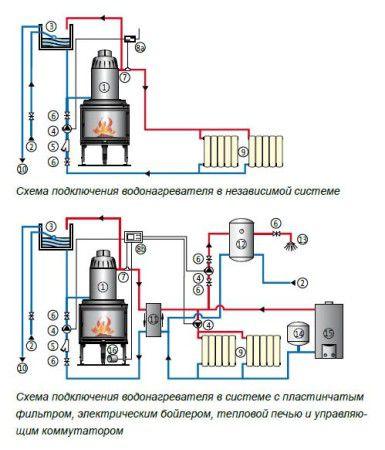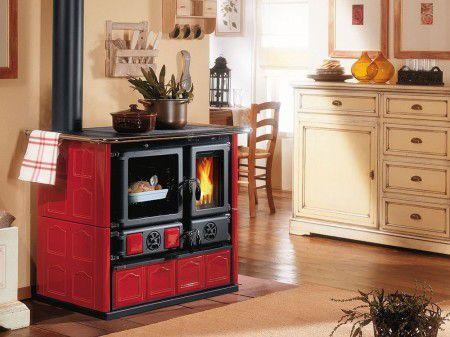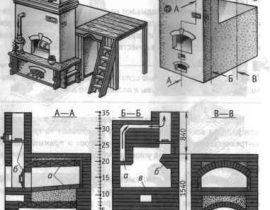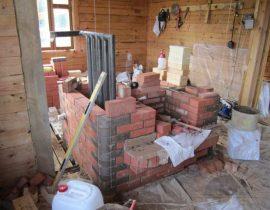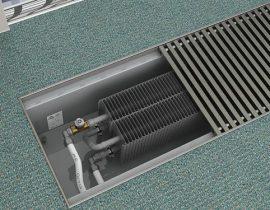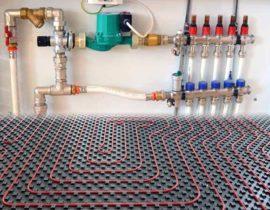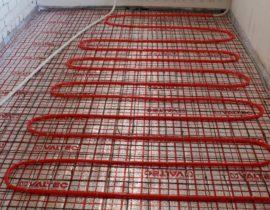A classic fireplace warms the room perfectly, but cannot heat the whole house for a long time, because its heat capacity is low.
Only a modified fireplace stove with a water circuit, with connected radiators in all rooms of the house, can cope with this task.
The area that such a circuit can heat depends on the heat output of the fireplace, the number of installed radiators and the total volume of water in the system. How to choose and install a fireplace stove with a water circuit, we will describe in this article, read carefully and follow absolutely all the requirements!
Content
The device of the stove-fireplace with a water circuit
According to its design, a fireplace stove with a water circuit differs little from a traditional fireplace, the only difference is that a heat exchanger with a coil is installed in the upper part of the furnace or in the walls of the furnace, through which the coolant circulates, most often ordinary water. The coil is connected to a closed heating circuit, consisting of radiators and connecting pipes, an expansion tank; if the system is long, a circulation pump is also installed.
The firebox of the fireplace stove can be either open or closed, protected by heat-resistant glass.In the lower part of the firebox there is a grate - a grate, through which the air necessary for burning firewood enters, and also combustion products - ash are discharged. There is an ash pan under the firebox, it also functions as a blower and is protected by a hinged door or is made in the form of a pull-out tray. At the top of the firebox is a smoke box that connects to the chimney. Depending on the model of the fireplace stove, pockets and openings for the convection outlet of heated air, flame cutters and other elements can also be provided.
There are also models in which the internal coolant circuit is not connected to the heating system, and the water circulating in the radiators is heated through a plate heat exchanger. Such furnaces are more convenient for double-circuit systems, which allow you to connect not only heating, but also hot water supply.
A fireplace stove with a water circuit can also be made of bricks. The walls of the furnace in such a furnace are double: the inner wall is made of metal, the outer wall is made of brick, and a coil is placed between them. However, it is not worth taking on the laying of such a furnace without having the appropriate experience - this work requires great accuracy and compliance with dimensions, and it is very difficult to remake the furnace during operation.
It is not advisable to install a fireplace stove with a water circuit as the only source of constant heating in cold climatic zones, since it is impossible to automate the combustion process, and it will not be possible to leave the house for a long time. However, as an additional or backup heating system, a fireplace stove will be very useful, especially during severe cold weather or bad weather.
Choosing a fireplace stove with a water circuit
The choice of a heating unit is a responsible matter, and before giving preference to one or another model, you need to understand the characteristics and capabilities of such furnaces. Let's try to consider the most important of them.
- Power. Unlike a conventional stove or fireplace, the manufacturer indicates two power values for heaters with a water circuit: the total heat output and the heat exchanger power. What do they mean? The total thermal power is the amount of heat that the stove is able to give off to the surrounding space through infrared radiation through the firebox glass and convection channels and from the heating system. Its integral part is the heat exchanger power, that is, the amount of heat that is supplied to the radiators. For example, the total declared thermal power of the fireplace stove with a water circuit is 11 kW, the heat exchanger power is 4 kW. Considering the heating required for every 10 m2 area power, which is taken equal to 1 kW, such a fireplace stove with a water circuit can heat a house with an area of 100-110 m2. At the same time, keep in mind that the declared power is designed for continuous operation of the stove, which is troublesome for wood-burning heaters, because firewood will have to be constantly added. If you plan to heat the fireplace stove only during the daytime, increase the required power value by 1.5-2 times.
- Dimensions and weight of the furnace. This characteristic is important if you are experiencing a lack of space and a limitation in the allowable load on the floors. The dimensions of the model you choose must allow it to be installed within fire clearances - these are usually indicated in the instruction manual.The load on the floor can not be considered if the floors in your house are made of monolithic concrete or reinforced concrete slabs, they will allow you to install a metal stove anywhere. For wooden floors, the maximum allowable live load is 150 kg, and with a weight of 100 kg and an area of \u200b\u200bthe base of the furnace less than 0.7 m2 this value will be exceeded. There are two ways out - choose a fireplace stove with a water circuit, which has less weight or redistribute the load, for example, using a podium for the stove. It can be made from a sheet of drywall with a thickness of at least 12 mm, covered with a non-combustible coating, for example, porcelain stoneware.
- Heat carrier volume. To connect the heat exchanger to the heating system, you will need to know the permissible limits of this value. The volume of the coolant is the sum of the volume of all pipes and radiators and depends on the length of the system and the number of battery sections. The volume of the radiator section can be found in the passport documentation, and the volume of pipes can be calculated from the table by measuring their diameter and total length. The resulting value must be increased by 10% - this is the volume of the expansion tank that is needed for home heating systems.
- Smoke channel diameter. This parameter is important for the selection of suitable chimney elements. If the purchase of all components takes place in one place, experts will help you choose the right diameter, otherwise you will have to choose the appropriate size elements yourself.
- Additional functions. These include the possibility of cooking and heating food on the top panel, easy glass cleaning systems, cold handles and other little things that will make the operation of the fireplace stove more convenient and enjoyable.Whether to pay extra money for all these features is up to you.
Installation of a fireplace stove with a water circuit and connection to the heating system
You bought a fireplace stove, radiators, pipes, an expansion tank and other elements of the heating system. It remains to install the furnace and connect it.
- Level the floor where the fireplace stove is to be installed. It is highly desirable to line it with non-combustible materials - if accidental sparks and coals hit, the floor will not catch fire.
- Install the fireplace stove and level it using the adjustable feet if necessary.
- Install a water heating system. For a gravity system, the installation of a circulation pump is not necessary; with a forced circulation system, the pump is placed at the coldest point of the return pipe, that is, before the return pipe enters the heat exchanger. The expansion tank is installed at the highest point in the system. It is better to choose a closed-type tank with a membrane - the less contact of the coolant with air, the longer the radiators and pipes will last you.
- Connect the heat exchanger to the heating system according to the selected scheme. Fireplace stoves with a water circuit can work both independently and connected to the heating system from the boiler as additional heating.
- Fill the water heating system with water or other heat transfer medium. Check all joints for leaks, test the operation of the circulation pump.
- Install the chimney and connect it to the flue of the stove. All joints must be coated with a heat-resistant sealant, and penetrations through the floors must be insulated with non-combustible materials.
- Carry out a trial firing of the stove.When burning, an unpleasant odor may appear - this is a consequence of the sintering of heat-resistant paint, which is used to paint the elements of the body. There will be no further smell.
- Check the heating of the coolant in the system and adjust the circulation rate, balance the system using the valves on the radiators.
After all these measures, the furnace can be operated normally. Do not forget to check the coolant level in the system. In case of a long absence, drain the water from the system; if it freezes accidentally, pipes and radiators may be damaged, which will lead to ruptures and leaks.
A fireplace stove with a water circuit is especially convenient for two-story country houses with a living room and several bedrooms: the living room is heated by the warmth of the fireplace, and radiators are installed in the bedrooms with the ability to control their heating. Such a system allows you to heat only the necessary rooms without installing a gas or electric boiler, and a live fire in the fireplace creates a romantic mood and provides you with a great holiday.
Can a fireplace stove with a water circuit explode - video answer

